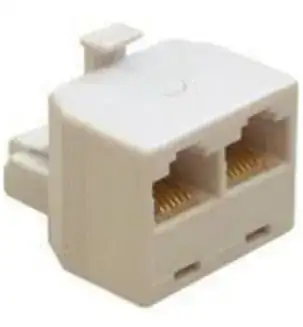At my work 20 years ago we lacked an RJ45 port. This was solved by plugging in a RJ45-doubler.
It was a passive adapter (so it was neither a switch nor a hub) and looked visually similar to:

The doubler had the effect that A and B both could reach the internet, but they could not reach each other, and IIRC it also limited the speed to 10 Mbps.
I can find many adapters that merge two RJ45 onto a single cable and then splits these at the other end of the cable with a similar adapter (so you would always buy these in pairs). This is not what I am looking for.
I am now in a similar situation: I have a router that includes a small switch that is just one port short, but I can easily find 2 cables that will never need to communicate, and where 10 Mbps would be sufficient even if shared and half-duplex (e.g. my printer, my VOIP-adapter, and possibly even my TV-box. None of these would ever communicate directly).
I can find products like this and this : "This Ethernet splitter allows three computers to share one Ethernet line one at a time, but it doesn't support three computers to connect onto the internet simultaneously."
20 years ago we really had multiple (2) computers using the same adapter simultaneously; the only limitation was that these computers could not connect to each other.
What should I search for to find such an adapter?
(Why not buy an additional switch? I want to try to avoid pollution. I have a 24 port old switch, but it uses 18 watts even when there is no traffic, and I would like to turn that off. A new switch might save on the power, but would cause pollution in production.)
 (EEWeb:
(EEWeb: